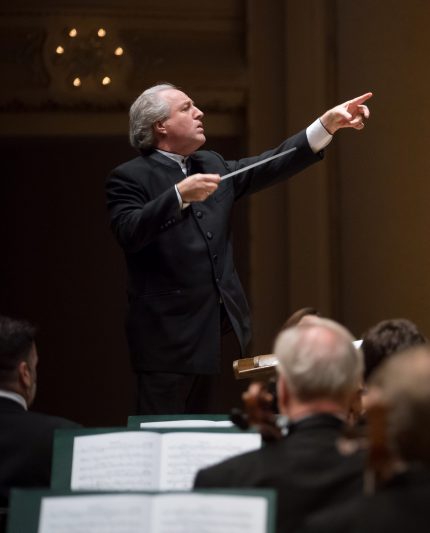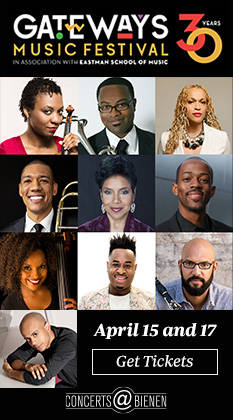Honeck leads CSO in an individual and triumphant Mahler Fifth

It’s hard to overstate the importance of Gustav Mahler’s music to the history of the Chicago Symphony Orchestra. In addition to its long and deserved reputation as one of the world’s most esteemed Mahler ensembles, many, if not most, of the CSO’s strongest podium relationships have been with celebrated Mahler conductors: Reiner, Solti, Giulini, Abbado and Haitink.
So there was great anticipation when Manfred Honeck led his first Mahler performance with the CSO Thursday night in the Symphony No. 5. The Austrian conductor has become a popular visitor in Chicago and, with Honeck routinely shortlisted on any roster of potential Riccardo Muti successors, there was more anticipation than usual in the hall.
Scored for huge orchestra and cast on a large canvas, the Fifth Symphony spans five movements, divided by the composer into three parts. The Fifth is an epic journey from dark tragedy to light and life–moving from the opening funeral march through violent turbulence, rustic energy, lyrical introspection. and finally a blazingly joyous finale.
Honeck’s approach to Mahler is an individual one, and parts of it are as likely to divide audiences as his bracing Schubert Ninth last November. Yet, despite some quibbles, one always felt this was a true Mahler journey–fresh, deeply considered and always at the service of the score.
Rather than speedy like that Schubert, this time Honeck’s tempos were more stately than one usually hears. Launched with a clarion trumpet call by Mark Ridenour–stellar all night–Honeck took the opening funeral cortege at the measured pace Mahler asks for–i.e., slower than is often done these days. Some may have felt that it risked dragging at times but Honeck and the players sustained that focused tempo skillfully, making its dogged, dirge-like return more striking and effective. The contrasting breakout episodes were given their due, brilliant and full-bodied in impact.
The second movement proved the most controversial. While the manic violence of the music was given full power, it felt at times that Honeck was pushing the climaxes with deafening tuttis and massive timpani attacks. One feared that the crucial brass chorale would be lost amid all the sonic tumult. Fortunately, that didn’t happen and its broad, majestic appearance–anticipating the triumphant coda to come–was magnificent, played with gleaming power and touching in its respite from the surrounding darkness.
Heeding Mahler’s wishes, Honeck marked the division of Part One with a longer pause than usual before launching into the central Scherzo. Here is where the music turns optimistic and where this performance truly came into its own. There was a wonderful rustic swagger and ebullience to the Landler rhythms, the moments of nostalgia were surely marked and Daniel Gingrich’s atmospheric Alpine horn solos led the inspired playing by the brass section.
While balancing was deft throughout, it seemed oddly off at the beginning of the Adagietto with the harp too loud next to the hushed strings. With quite unearthly string playing, Honeck led a more searching and interior rendering of this affecting music than usual, sentimentality held at bay, yet the climax emerging with lyric warmth and expressive ardor.
The transition into the finale was beautifully done, and the concluding Rondo was fast and exhilarating, building steam inexorably to the shout of the triumphant coda, the most joyous finale Mahler ever wrote.
With playing across all sections at a level impressive even by CSO standards, Honeck and the orchestra were rewarded with one of the loudest and longest ovations of the season. Cheers and repeated curtain calls brought the conductor back out to make generous acknowledgments of CSO sections and principals with solo bows.
Mozart often makes a congenial prelude to Mahler and so it proved again with his Piano Concerto No. 25 performed by Till Fellner on the first half.
Like his compatriot Honeck, Fellner is often at his best in the central Austro-German cornerstone repertoire. He is a superb Mozartian, playing with easy fluency and pearly tone, ideally suited to this music. His singing way with a phrase in the Andante and buoyant articulation in the gently galumphing Allegretto finale were all pleasure.
Yet while coordination was deft and polished, soloist and conductor didn’t always seem to be on the same page stylistically. K. 503 is scored for larger forces than most of Mozart’s keyboard concertos, which Honeck seized upon on his full-bore accompaniment. The conductor’s emphatic approach seemed to thrive on a tightly coiled tension, largely leaving the music’s charm in the dust. (Stefán Ragnar Höskuldsson’s flute solos made up some of that deficit.)
Also the performance still seemed to be finding its footing Thursday, with wind textures less well blended than one expects in this repertory. With a Mahler symphony on the same program, it was hard not to feel that Mozart got the short end of the rehearsal stick.
The program will be repeated 7:30 p.m. Friday at Wheaton College and 8 p.m. Saturday and 7:30 p.m, Tuesday at Symphony Center. cso.org; 312-294-3000.
Posted in Performances






Posted Jan 26, 2018 at 10:54 pm by Peter Borich
In an otherwise spectacular performance, I found the second movement to be a disappointment. The heaviness of the movement led to a less than impressive transition from dark to light…..and since the second movement is so, so important to the success of the entire work, it detracted from the overall excellence of Maestro Honneck’s interpretation.
Posted Jan 27, 2018 at 11:49 pm by Paul Cohan
You might play it differently, but you will not play it much better.
Beyond the spectacular podium performance . . . what else can one say about this orchestra? The two most important principals in this symphony, trumpet and horn, are “holding” their seats.
On to Mahler 9 in May with Mr. Salonen.